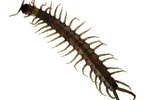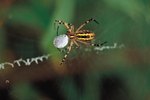
Many people who roam the planet are familiar with the sight of centipedes, kin to insects and part of the class Chilopoda. After all, the venomous arthropods exist all over the planet, and in countless species, some a lot larger or smaller than others. These invertebrates lead nocturnal lives.
Centipede Details
Centipedes, in the majority of cases, spend their time in wet environments on terra firma, whether amidst foliage or below stones and decaying logs. They frequently even enter human residences, particularly cellars, closets and restrooms. Although not too common, some centipedes are capable of staying alive in desert environments. Centipedes are predominantly flesh-eating creatures, and insects are their primary dietary preference. They also frequently eat spiders. Particularly big centipedes sometimes go after lizards. Although centipede bites can be ouch-inducing to humans, they're not fatal. Bites from bigger centipedes might be hazardous, however, which is why prompt medical attention is a must.
Reproduction
Male specimens initiate reproduction by churning out tiny webs. They use these webs as vessels for packages of sperm, which they leave for female centipedes to retrieve. The females then insert these packages into their genitals. They set their eggs down below logs, stones or tree bark, and sometimes even in the dirt. Many female centipedes do carefully watch over their eggs, but this behavior depends on the exact species. Egg-laying occurs in warm times of the year.
Wooing Activities
Wooing activities are common in many types of centipedes, but not in all of them. Male centipedes sometimes employ their antennae to lightly rap against the females' back legs, a means of getting them -- the females -- to transfer the sperm into their genitals.
Youngsters
When wee centipedes emerge from their eggs, they frequently appear similar to adults, just on smaller scales -- think segments, legs and the works. Other types of young centipedes, however, have more growth and development ahead of them. With molting, these centipedes start looking closer and closer to mature individuals. Lots of centipede mothers provide parental assistance for their juveniles, huddling around them and refusing to eat until the little guys are a little stronger and more realized.
References
- University of Michigan BioKIDS: Centipedes
- Commonwealth Science and Industrial Research Organization Ecosystem Sciences: Chilopoda - Centipedes
- Wildlife Journal Junior: Chilopoda - Centipedes
- Virginia Cooperative Extension: Centipede - Chilopoda
- Animal Planet: Centipede
- Field Guide to the Samoan Archipelago; Meryl Rose Goldin
Photo Credits
-
Brand X Pictures/Brand X Pictures/Getty Images




